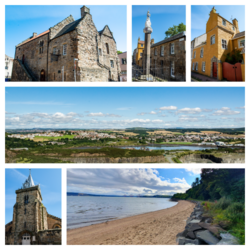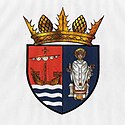Inverkeithing
| |
|---|---|
| Town & Royal Burgh | |
| Clockwise from top left: Friary, Mercat Cross, Thomsoun's House, view of town, Inverkeithing Bay beach & St. Peter's Church.Inverkeithing Coat of Arms | |
Location near the City of Edinburgh council area Location within Fife | |
| Population | 4,820 (2022)[4] |
| OS grid reference | NT130829 |
| • Edinburgh | 9 mi (14 km) S |
| • London | 340 mi (550 km) S |
| Council area | |
| Lieutenancy area | |
| Country | Scotland |
| Sovereign state | United Kingdom |
| Post town | Inverkeithing |
| Postcode district | KY11 |
| Dialling code | 01383 |
| Police | Scotland |
| Fire | Scottish |
| Ambulance | Scottish |
| UK Parliament | |
| Scottish Parliament | |
Inverkeithing (/ɪnvərˈkiːðɪŋ/ ; Scottish Gaelic: Inbhir Chèitinn) is a coastal town, parish and historic Royal burgh in Fife, Scotland. The town lies on the north shore of the Firth of Forth, 9.5 miles northwest of Edinburgh city centre and 4 miles south of Dunfermline.
A town of ancient origin, Inverkeithing became an important centre of trade and pilgrimage during the Middle Ages.[5] Inverkeithing was granted Royal burgh status by 1161 and became the host of the annual Convention of Royal Burghs from 1487.[6] The town witnessed the Battle of Inverkeithing in 1651, a conflict in the Wars of the Three Kingdoms. Following the Industrial Revolution, Inverkeithing developed industries in distilling, ship breaking and quarrying.[7][8]
Inverkeithing town centre is a conservation area, home to 41 listed historic buildings including the best-preserved medieval friary in Scotland[9][10] and one of the finest examples of a medieval Mercat Cross.[11] Inverkeithing features on the Fife Coastal Path, one of Scotland's Great Trails, and the Fife Pilgrim Way.
Inverkeithing railway station is a main stop for trains running over the nearby Forth Rail Bridge, and the town is home to the Ferrytoll Park & Ride. Around half of Inverkeithing's workers work in Edinburgh city centre or Dunfermline (2024).[12] The town has a population of 4,820 (2020)[13] and the civil parish has a population of 8,878 (2022).[14]
- ^ "Ainmean-Àite na h-Alba – Gaelic Place-Names of Scotland". www.ainmean-aite.scot. Archived from the original on 10 October 2019. Retrieved 25 June 2021.
- ^ "Fife Place-name Data :: Inverkeithing". fife-placenames.glasgow.ac.uk.
- ^ Ann McCluskey. "Land, Sea and Sky – Travelogue" (PDF).
- ^ "Mid-2020 Population Estimates for Settlements and Localities in Scotland". National Records of Scotland. 31 March 2022. Retrieved 31 March 2022.
- ^ Cite error: The named reference
Inverkeithing Conservation Area Appraisalwas invoked but never defined (see the help page). - ^ Cite error: The named reference
:4was invoked but never defined (see the help page). - ^ Simpson, Anne Turner (1981). Historic Inverkeithing The Archeological Implications of Development. Glasgow: Scottish Burgh Society. p. 4.
- ^ GENUKI. "Genuki: Inverkeithing, Fife". www.genuki.org.uk. Retrieved 5 March 2024.
- ^ Fife Council (2019). "Inverkeithing Conservation Area Appraisal and Management Plan" (PDF). Fife historic buildings.
- ^ Fife Historic Buildings Trust. "Inverkeithing Friary & Friary Gardens" (PDF). Fife Historic Buildings. Retrieved 5 March 2024.
- ^ "Inverkeithing Mercat Cross". Fife Coast & Countryside Trust. Retrieved 7 October 2024.
- ^ Cite error: The named reference
:6was invoked but never defined (see the help page). - ^ "National Records of Scotland". National Records of Scotland. 31 March 2022. Retrieved 27 December 2023.
- ^ Census of Scotland 2022, Table UV101b – Usual Resident Population by sex by age, publ. by National Records of Scotland. Web site http://www.scotlandscensus.gov.uk/ retrieved May 2024. See "Standard Outputs", Table UV101b, Area type: Civil Parish 1930



